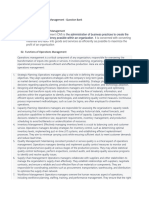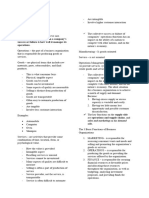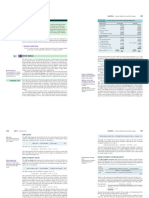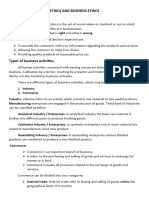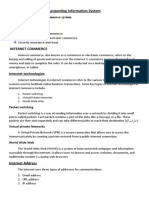0 ratings0% found this document useful (0 votes)
12 viewsOperational Management and Its Functions
Uploaded by
Imtiaz SultanCopyright
© © All Rights Reserved
Available Formats
Download as PDF, TXT or read online on Scribd
0 ratings0% found this document useful (0 votes)
12 viewsOperational Management and Its Functions
Uploaded by
Imtiaz SultanCopyright
© © All Rights Reserved
Available Formats
Download as PDF, TXT or read online on Scribd
You are on page 1/ 3
Operational Management and its Functions
### Operational Management
**Operational Management** involves overseeing, designing, and controlling the
processes of production and redesigning business operations in the production of goods or
services. It focuses on ensuring that an organization operates efficiently and effectively by
managing resources, including human, financial, and physical assets, to produce and deliver
products and services.
### Types of Operational Management
1. **Production Management**:
- Focuses on the production of goods and services.
- Includes planning, scheduling, and controlling production processes.
- Ensures products are produced on time, within budget, and at the desired quality.
2. **Supply Chain Management**:
- Involves managing the flow of goods and services from suppliers to customers.
- Includes procurement, logistics, inventory management, and distribution.
- Aims to optimize the entire supply chain to reduce costs and improve efficiency.
3. **Quality Management**:
- Focuses on ensuring products and services meet customer expectations and standards.
- Includes quality control, quality assurance, and continuous improvement practices.
- Utilizes methodologies like Total Quality Management (TQM) and Six Sigma.
4. **Inventory Management**:
- Involves managing the storage, ordering, and use of inventory.
- Includes techniques like Just-In-Time (JIT) inventory and Economic Order Quantity (EOQ).
- Aims to minimize inventory costs while meeting customer demand.
5. **Project Management**:
- Focuses on planning, executing, and closing projects.
- Involves defining project goals, managing resources, and ensuring timely delivery.
- Uses methodologies like Agile, Scrum, and Waterfall.
6. **Process Management**:
- Involves designing, implementing, and optimizing business processes.
- Aims to improve efficiency, reduce costs, and enhance productivity.
- Utilizes tools like Business Process Reengineering (BPR) and Lean Management.
7. **Service Operations Management**:
- Focuses on managing the delivery of services rather than goods.
- Includes service design, service delivery, and customer relationship management.
- Aims to improve service quality and customer satisfaction.
8. **Maintenance Management**:
- Involves ensuring that equipment and facilities are kept in optimal working condition.
- Includes preventive maintenance, corrective maintenance, and predictive maintenance.
- Aims to reduce downtime and extend the life of assets.
9. **Human Resources Management (HRM)**:
- Focuses on managing an organization's workforce.
- Includes recruitment, training, performance management, and employee relations.
- Aims to optimize employee performance and satisfaction.
10. **Financial Operations Management**:
- Involves managing an organization's financial resources.
- Includes budgeting, forecasting, financial analysis, and cost control.
- Aims to ensure financial stability and profitability.
### Functions of Operational Management
1. **Planning**:
- Defining organizational goals and determining the best way to achieve them.
- Includes strategic planning, capacity planning, and resource planning.
2. **Organizing**:
- Arranging resources and tasks to implement the plan effectively.
- Includes structuring teams, allocating resources, and defining roles and responsibilities.
3. **Leading**:
- Motivating and guiding employees to achieve organizational goals.
- Includes leadership, communication, and team management.
4. **Controlling**:
- Monitoring performance and making adjustments to stay on track with goals.
- Includes performance measurement, quality control, and corrective actions.
5. **Coordinating**:
- Ensuring different parts of the organization work together harmoniously.
- Includes managing interdependencies between departments and processes.
6. **Improving**:
- Continuously seeking ways to enhance processes, products, and services.
- Includes innovation, process optimization, and adopting new technologies.
Operational management is crucial for the efficiency and effectiveness of an organization's
production and service delivery. It ensures that resources are used optimally to meet
customer needs and achieve organizational objectives.
You might also like
- TPL - Application Form (Part B) (CREA CULT)No ratings yetTPL - Application Form (Part B) (CREA CULT)20 pages
- Lesson 1 - Operation Managment - Sir HenryNo ratings yetLesson 1 - Operation Managment - Sir Henry22 pages
- Operations Management Summary Reviewer Chapter 1 To 3No ratings yetOperations Management Summary Reviewer Chapter 1 To 36 pages
- Understanding Operations Management: Assignment 1No ratings yetUnderstanding Operations Management: Assignment 16 pages
- Operations Management- Draft for ReportingNo ratings yetOperations Management- Draft for Reporting13 pages
- Chapter 1 - Introduction to Operations ManagementNo ratings yetChapter 1 - Introduction to Operations Management34 pages
- Introduction To Operations Management and Quality ManagementNo ratings yetIntroduction To Operations Management and Quality Management20 pages
- 1 - Introduction For OSCM and ManagementNo ratings yet1 - Introduction For OSCM and Management29 pages
- Report On Operations Management Pepsi: (Type The Document Subtitle)No ratings yetReport On Operations Management Pepsi: (Type The Document Subtitle)11 pages
- Operations Management Is A Branch That Deals With Managing Operations and ProcessesNo ratings yetOperations Management Is A Branch That Deals With Managing Operations and Processes2 pages
- Operational Management SUMMARY CHAPTER 1No ratings yetOperational Management SUMMARY CHAPTER 19 pages
- 15 marks 2 marks Enterprise resource planningNo ratings yet15 marks 2 marks Enterprise resource planning18 pages
- The Art and Science of Auditing: Principles, Practices, and InsightsFrom EverandThe Art and Science of Auditing: Principles, Practices, and InsightsNo ratings yet
- Final IBF (Numerical) Chapter 2, 5 & 15No ratings yetFinal IBF (Numerical) Chapter 2, 5 & 1513 pages
- How To Effectively Select Players On A National Team To Boost Faith and MoraleNo ratings yetHow To Effectively Select Players On A National Team To Boost Faith and Morale4 pages
- MMA 2023-149 NoA of ISO Standard On Public TransportNo ratings yetMMA 2023-149 NoA of ISO Standard On Public Transport2 pages
- Assessing Risk - Ensuring Internal Audit's ValueNo ratings yetAssessing Risk - Ensuring Internal Audit's Value5 pages
- Planned Job Observation Report: ELEMENT 5.20bNo ratings yetPlanned Job Observation Report: ELEMENT 5.20b1 page
- Supply Chain Management: Strategy, Planning, and OperationNo ratings yetSupply Chain Management: Strategy, Planning, and Operation12 pages
- Chapter 11 Risk Management PresentationNo ratings yetChapter 11 Risk Management Presentation16 pages
- Jollibee Foods Corp. Financial Forecasting Assignment v4 - Net Inc UpdateNo ratings yetJollibee Foods Corp. Financial Forecasting Assignment v4 - Net Inc Update12 pages
- Instant Ebooks Textbook (Ebook PDF) Supply Chain Logistics Management 5th Edition by Donald Bowersox Download All Chapters100% (1)Instant Ebooks Textbook (Ebook PDF) Supply Chain Logistics Management 5th Edition by Donald Bowersox Download All Chapters41 pages









